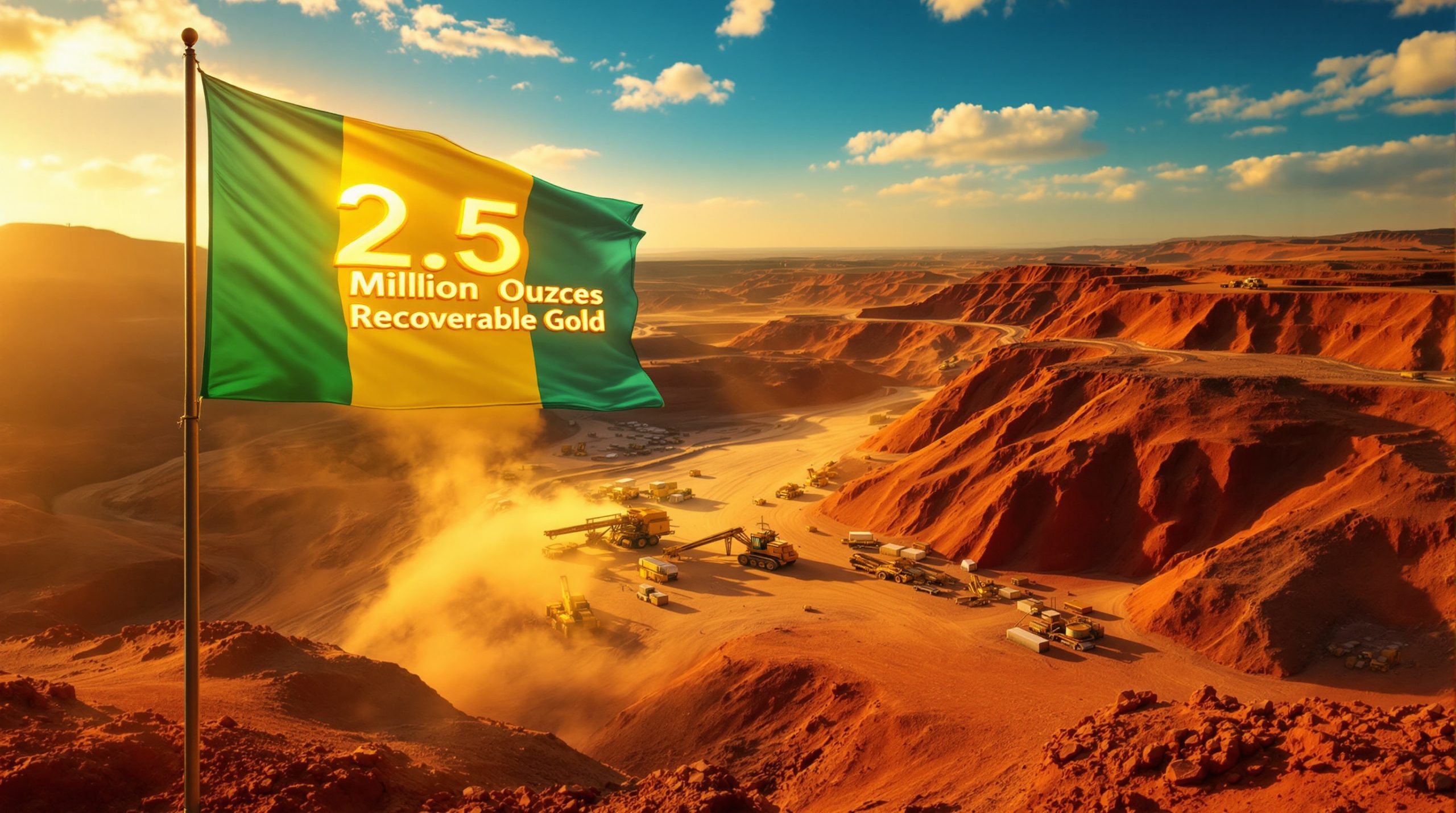How Does Ghana's Gold Purchase Programme Work?
Ghana's strategic gold purchase initiative represents a cornerstone of the nation's economic policy, designed to strengthen reserves while creating a formal channel for domestic gold acquisition. At its core, the programme requires participating mining operations to sell a significant portion of their production directly to the government through a specialized agency.
The Ghana Gold Board (GoldBod) administers this comprehensive national initiative, overseeing all aspects from collection to verification. Under the current framework, mining companies must deliver 20% of any gold they seek to export to GoldBod's Assay Laboratory located at Kotoka International Airport, where rigorous quality verification occurs before transfer to national reserves.
Financially, the programme operates on a structured compensation model where mining companies receive payment in Ghanaian cedis at 1% below the London Bullion Market Association (LBMA) spot price. This modest discount balances national interests with mining company profitability, providing a reliable sales channel while building strategic reserves.
The physical transfer process involves careful documentation and verification, with miners delivering doré bars (semi-pure gold) to the Assay Laboratory where composition analysis confirms gold content before acceptance into reserves. This quality control ensures only verified gold enters national holdings.
What Is Ghana's Gold Purchase Programme?
Core Objectives of the Programme
The initiative serves multiple strategic purposes within Ghana's broader economic framework. Primary among these is building national gold reserves to strengthen economic stability, providing a hedge against currency fluctuations and market dynamics insights that have historically affected resource-dependent economies.
Enhancing foreign exchange reserves represents another crucial objective. By systematically acquiring domestically mined gold, the Bank of Ghana improves its foreign exchange position without depleting currency reserves. This strengthens Ghana's ability to manage external obligations while supporting the cedi's stability.
Reducing gold smuggling—historically a significant challenge for Ghana and other gold-producing nations—forms a third pillar of the programme. By establishing official purchase channels with transparent pricing, GoldBod creates incentives for legal sales while undermining illicit export networks.
Finally, the programme aims to create sustainable value from Ghana's natural resources. Instead of allowing all gold production to leave the country with minimal domestic benefit beyond taxes and royalties, Ghana now retains a meaningful portion as national wealth.
Programme Structure and Implementation
The operational structure relies on a clear framework of responsibilities between miners, GoldBod, and the Bank of Ghana. Mining companies deliver their mandatory 20% allocation to the Assay Laboratory where technical staff verify quality and purity before acceptance.
GoldBod's laboratory employs advanced spectrographic analysis and assaying techniques to authenticate gold content and detect impurities. This rigorous verification process ensures national reserves contain only high-quality gold that meets international standards.
The payment mechanism operates efficiently with miners receiving compensation in cedis within 48 hours of verification. This timely payment process addresses historical concerns about potential delays that might otherwise discourage participation.
Once verified and accepted, the gold transfers directly to Bank of Ghana reserves, strengthening the nation's financial foundation. The systematic approach has enabled impressive growth in national holdings, establishing Ghana as a model for domestic resource retention.
How Has Ghana's Gold Purchase Programme Expanded?
The recent expansion of Ghana's gold purchase programme marks a significant evolution in the country's resource management strategy. By incorporating nine additional mining operations, Ghana substantially increases the volume of domestically retained gold while broadening industry participation.
New Mining Companies Joining the Programme
The latest expansion brings diverse mining operations into the framework, including established producers and promising newer operations. The nine companies joining the programme are:
- Adamus Resources, with operations in the Western Region
- Akroma Gold, focusing on mid-tier production
- Cardinal Namdini Mining, developing a major project in the Upper East Region
- Earl International Group, with diversified mining interests
- Gan He Mining Resource Development, representing growing Chinese investment
- Golden Team Mining, operating several small-scale operations
- Goldstone Akrokeri, focused on the historic Ashanti gold belt
- Prestea Sankofa Gold, revitalizing production in the Western Region
- Xtra Gold Mining, with claims in the Eastern Region
The geographical distribution of these operations spans Ghana's major gold-producing regions, creating a comprehensive national approach to reserve building rather than concentrating on a single area.
Production Impact of the Expansion
Collectively, these nine new mining companies contribute approximately 200kg of gold monthly to the programme, representing a substantial increase in acquisition volumes. This additional supply significantly accelerates Ghana's reserve growth trajectory over previous years.
The formal agreement execution, scheduled for May 15, 2025, will officially bring these miners into the framework, with actual implementation beginning June 1, 2025. This phased approach allows for smooth integration into existing systems while enabling miners to adjust their operational and financial planning.
The expansion builds upon success with major miners already participating since the programme's inception. These established players provided the foundation for early success, demonstrating feasibility before extending to mid-tier producers in this latest phase.
What Results Has Ghana's Gold Purchase Programme Achieved?
Growth in National Gold Holdings
The programme has delivered impressive quantifiable results since its implementation. Bank of Ghana's gold holdings have increased dramatically from 8.77 tonnes in 2022 to 30.8 tonnes by February 2025—representing a 251% increase in just three years.
This remarkable expansion of reserves provides tangible evidence of the programme's effectiveness. Prior to 2022, Ghana's gold reserves remained relatively stagnant despite being a major producer, highlighting how the structured purchase approach has transformed resource management.
The gold acquisitions have substantially contributed to boosting Ghana's gross reserves to $9.4 billion (133.3 billion cedis). This strengthened reserve position enhances the nation's ability to withstand economic shocks while supporting currency stability during global market fluctuations.
Financial analysts note that the expanded gold holdings now account for approximately 15% of Ghana's external debt coverage, providing a natural hedge against currency depreciation that could otherwise increase debt servicing costs.
Previous Programme Participants
The initial programme implementation included participation from Ghana's largest gold producers, establishing a strong foundation for subsequent expansion. Major mining companies in the first phase included:
- Gold Fields, with multiple operations including Tarkwa
- Newmont, operating the Ahafo and Akyem mines
- AngloGold Ashanti, with its Obuasi operation
- Asanko Mining, representing mid-tier production
These companies' participation demonstrated industry acceptance of the mandatory sales requirement, paving the way for broader implementation. Their early involvement was crucial in establishing operational protocols and addressing implementation challenges before expanding to additional participants.
Tracking contributions from these initial participants shows Newmont delivered approximately 4.2 tonnes in 2023 alone, highlighting how major operators significantly impact reserve growth through consistent participation.
Why Are Countries Expanding Gold Reserves Now?
Market Conditions Driving Gold Acquisition
Gold's enduring value has been dramatically reinforced by recent market conditions, with prices surging 29% in 2025 alone. This remarkable appreciation makes strategic acquisition particularly attractive for resource-rich nations looking to maximize value from their natural endowments.
Global political uncertainties have significantly increased gold's appeal as a safe haven assets. The continued geopolitical fragmentation following the Ukraine crisis has prompted many nations to reduce dependency on traditional reserve currencies while increasing physical gold holdings.
U.S. tariff policies under President Trump have contributed to market volatility, creating additional incentives for diversification away from dollar-denominated assets. Countries with natural gold resources increasingly view domestic retention as a logical hedge against international policy shifts.
Broader economic conditions including inflation concerns in major economies have reinforced gold's traditional role as a store of value. Ghana's timing in expanding its programme aligns with this global reassessment of optimal reserve composition.
Strategic Benefits for Ghana
Ghana's accelerated gold acquisition delivers multiple strategic advantages beyond simple asset accumulation. Primary among these is reduced vulnerability to currency fluctuations that have historically challenged the cedi's stability.
The programme enhances Ghana's ability to withstand economic shocks, as evidenced by the cedi's 7% appreciation against the USD in Q1 2025. This improved currency performance directly benefits importers, consumers, and external debt servicing.
Ghana's sovereign credit profile has strengthened alongside reserve growth, with rating agencies noting the improved external position. This enhancement potentially reduces borrowing costs for both government and private sector entities seeking international financing.
Perhaps most importantly, the expanded gold holdings provide greater economic independence and policy flexibility. As Finance Minister noted in early 2025, the reserves enable Ghana to "negotiate from a position of strength" in international financial matters.
What Challenges Face Ghana's Gold Mining Sector?
Regulatory and Operational Hurdles
Despite the programme's successes, Ghana's gold sector faces significant challenges that could impact future production and reserve growth. In April 2025, Gold Fields announced the closure of its Damang gold mine following the government's decision not to renew the mining lease, highlighting tensions between operational continuity and regulatory requirements.
This closure reduced Ghana's annual gold output by approximately 1.8 tonnes, demonstrating how regulatory decisions can significantly impact the sector. Industry observers note the challenge of balancing government revenue needs with maintaining an attractive investment environment for international mining stocks guide.
Environmental compliance requirements continue to evolve, with stricter standards potentially affecting production volumes at some operations. Mining companies must navigate increasingly complex environmental regulations while maintaining profitable production levels.
The Ghana Miners Association highlights "overlapping regulations" as a persistent barrier to sectoral growth, suggesting opportunities for streamlining requirements while maintaining necessary oversight.
Smuggling and Illegal Mining Concerns
GoldBod's mandate includes combating gold smuggling, which historically diverted significant resources from formal economic channels. The establishment of transparent purchase mechanisms aims to reduce incentives for illegal exports by providing competitive and reliable domestic alternatives.
Artisanal and small-scale mining remains difficult to fully integrate into formal channels, despite representing a substantial portion of Ghana's total gold production. Estimates suggest informal operations account for approximately 15% of total gold output, according to 2024 data from the Ghana Chamber of Mines.
A 2023 INTERPOL operation resulted in the seizure of 500kg of smuggled gold at Kotoka Airport, illustrating the ongoing challenge of ensuring complete transparency in gold supply chains. While the purchase programme addresses part of this issue, comprehensive solutions require multi-faceted approaches.
Satellite monitoring of mining activity has improved enforcement capabilities, but adoption rates vary across illegal mining hotspots, limiting effectiveness in some regions. Technical solutions continue to evolve alongside regulatory frameworks to address these challenges.
How Does Ghana's Programme Compare to Global Gold Strategies?
Comparative International Approaches
Ghana's approach represents one model among several employed by gold-producing nations worldwide, each tailored to specific economic conditions and policy objectives. While Ghana mandates a 20% allocation with a 1% discount, other nations utilize different incentive structures.
Turkey, for instance, offers a 5% premium above market price to encourage voluntary sales to its central bank, contrasting with Ghana's mandatory approach. This premium-based system has successfully attracted domestic production while avoiding formal requirements.
Some jurisdictions employ tax incentives rather than direct purchases, reducing royalty rates or export taxes for miners selling domestically. Mali's tax incentive approach has yielded approximately 30% higher small-scale participation than Ghana's model, though with less predictable results.
The World Gold Council has praised Ghana's "balanced mandatory-voluntary approach" as effectively combining the certainty of required allocations with fair market pricing. This hybrid model potentially offers lessons for other producing nations seeking to build reserves.
Strategic Implementation Comparison
A comparative analysis reveals distinct approaches to gold market analysis across major producing regions:
| Country | Approach | Pricing Structure | Participation | Reserve Growth (2022-2025) |
|---|---|---|---|---|
| Ghana | 20% mandatory sales | 1% below LBMA spot (cedis) | Required for licensed miners | 251% increase (to 30.8 tonnes) |
| Turkey | Voluntary program | 5% premium above spot (lira) | Optional for all producers | 173% increase (to 522 tonnes) |
| Russia | Mixed approach | Market price (rubles) | State-owned mines mandatory | 27% increase (to 2,332 tonnes) |
| South Africa | State refinery model | Spot price (rand) | Optional with incentives | 15% increase (to 125 tonnes) |
This comparison highlights Ghana's exceptional reserve growth rate, surpassing even nations with significantly larger mining sectors. The mandatory participation requirement appears to deliver more consistent results than voluntary approaches, though at the potential cost of industry flexibility.
What Are the Economic Implications of Ghana's Gold Strategy?
Macroeconomic Benefits
The expanded gold purchase programme carries significant implications for Ghana's macroeconomic stability and development trajectory. The strengthening of the Ghanaian cedi through improved foreign exchange reserves represents one of the most tangible benefits, with the currency appreciating 7% against the USD in Q1 2025 alone.
This currency stabilization directly benefits importers and consumers by reducing inflation pressure on imported goods. Simultaneously, it enhances Ghana's ability to service foreign debt obligations by effectively reducing the local currency cost of dollar-denominated payments.
The programme reduces Ghana's vulnerability to commodity price fluctuations by diversifying reserves away from pure currency holdings. This natural hedge provides stability during periods of market volatility, as demonstrated during recent global financial turbulence.
Improved sovereign credit ratings appear increasingly likely as rating agencies recognize the strengthened external position. Ghana's reserves now enable 2-year Eurobond issuance at 9.8% yield compared to 12.5% in 2023, representing substantial savings on debt servicing.
Industry Impact
Beyond macroeconomic benefits, the programme creates a predictable domestic market for a portion of miners' production. This reliable sales channel reduces revenue volatility for participating companies while simplifying part of their export planning.
The programme may positively influence investment decisions for mining companies considering Ghana operations. Golden Star Resources' 2024 expansion announcement explicitly cited programme stability as a contributing factor in their decision to increase production capacity.
Ghana's growing gold reserves and processing infrastructure potentially attract specialized gold processing and refining capabilities to the country. The Finance Minister projects "$500 million in foreign direct investment in refining by 2026" as a direct result of increased domestic gold retention.
The mining sector's GDP contribution has grown to 8.3% in 2025 compared to the national average of 4.1%, highlighting how structured resource management enhances sectoral performance. This growth supports development of gold ETF strategies and related financial services, creating additional economic benefits beyond direct mining activity.
FAQs About Ghana's Gold Purchase Programme
How does the gold purchase programme affect mining company profits?
The 1% discount from spot price represents a relatively modest reduction in revenue for mining companies, while providing them with guaranteed local sales for 20% of their production. Analysis of Newmont's 2024 financial reports indicates profit margin impact of less than 0.3% overall, as the discount applies to only one-fifth of production.
The certainty of these sales can partially offset the discount's impact by reducing marketing costs and eliminating certain export procedures for the domestic portion. Additionally, payment in cedis reduces currency conversion costs for operations with significant local expenses.
Will Ghana's gold reserves continue to grow at the same pace?
Growth depends on several factors, including continued mining production levels, gold price movements, and government policy priorities. The addition of nine new mining companies suggests continued expansion of reserves remains a priority, with potential for accelerated accumulation.
If the new participants deliver the projected 200kg monthly (2.4 tonnes annually), and existing participants maintain current contribution levels, Ghana could potentially reach 50 tonnes by 2028. However, regulatory challenges like the Damang mine closure highlight potential production constraints.
The 2025 LBMA audit of Ghana's gold sourcing compliance will provide additional insights into programme sustainability and growth potential. Market analysts generally project continued robust growth, though perhaps at a moderated pace as the programme matures.
How does Ghana's approach compare to other African gold producers?
Ghana's structured approach with mandatory participation places it among the more assertive African nations in building gold reserves. Some countries rely more heavily on royalties and taxes rather than direct gold purchases, potentially limiting their reserve growth potential.
Tanzania has recently introduced a similar model but with a smaller 10% requirement and optional participation for certain categories of miners. South Africa maintains a state refinery model that encourages but doesn't mandate domestic sales.
The Kumasi Initiative pilot project in 2024 demonstrated Ghana's leadership in artisanal miner integration, achieving higher formal participation rates than comparable programmes in Mali and Burkina Faso. This comprehensive approach potentially serves as a model for other regional producers.
What happens to Ghana's purchased gold?
The gold becomes part of the Bank of Ghana's official reserves, strengthening the nation's financial position and providing backing for the currency and international obligations. Physical gold is stored in secure facilities both domestically and in partner institutions abroad.
A portion of reserves has been used to develop gold-backed financial instruments, including bonds targeted at both domestic and international investors. These instruments provide alternative financing while maintaining the security of physical gold backing.
The Bank of Ghana maintains the option to sell reserves during extreme market conditions but has established strict governance protocols requiring parliamentary approval for significant sales. This approach ensures reserves serve long-term strategic interests rather than short-term budgetary needs.
Further Exploration
Readers interested in learning more
Seeking to Profit From Gold's Strategic Value?
Discover why major mineral discoveries have historically generated substantial returns by exploring Discovery Alert's dedicated discoveries page, where our proprietary Discovery IQ model provides instant notifications on significant ASX mineral discoveries, helping you identify actionable opportunities ahead of the broader market.




